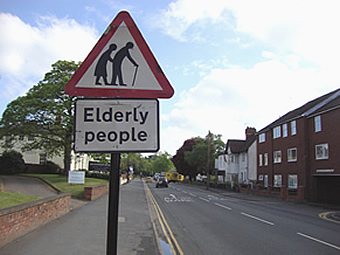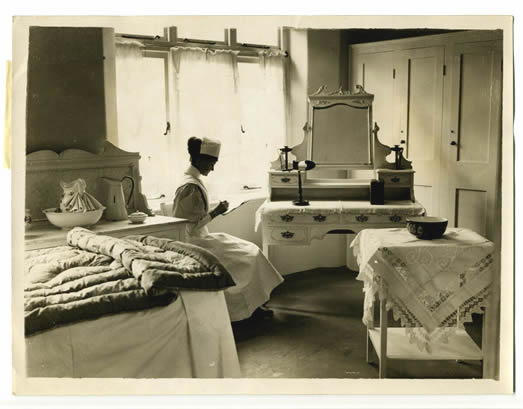Provision of care today
Our recognition of our physical limitations as a key factor in defining old age hasn’t really changed.

Road sign to alert for Elderly people crossing (A J Leon, cc-by/2.0, https://www.flickr.com/photos/ajleon/4662995633)
Our attitudes towards the elderly and what the experience of old age should be has, however. We have increasingly learned to recognise that our population is steadily ageing and that this needs to be catered for because more of us are living into our 80s, 90s, 100s and even 110s!
Record numbers of us are now living to be what are termed 'supercentenarians' – living until we are 110 years or over and this is happening across the whole UK, seemingly irrespective of local environments. Has there been a supercentenarian in your area?
Supercentenarians (Scribblemap)
Post-industrial Britain has seen a breakdown of the extended family, with more of us moving away from our roots, living in nuclear families, with both parents in full time employment. This means that far more of us are vulnerable in old age and cannot rely on our children for the provision of our care. In 1905, a Royal Commission found that workhouses were no longer suitable for all types of residents, and in 1918, the Local Government Committee on the Poor Law recommended the abolition of workhouses. The workhouse system was only abolished in 1930, however, and it was the catalyst of the Second World War that brought about the final abolition of the workhouses via the National Assistance Act 1948. After this, most of the workhouse buildings were converted into retirement homes for the elderly.
Nursing homes, as they were once known, were also heavily regulated following the Nursing Homes Registration Act 1927 and much improvement in standardising the quality of shelter provided, including the provision of central heating, followed Peter Townsend’s The Last Refuge report.
However, it was not until the Care Standards Act in 2000, enforced in 2002, that nursing homes were recognised as care homes for the elderly. The Act ensured the training of staff and the introduction of a new set of minimum care standards. Accessibility based on finances is still a major issue, however. Currently, only 3% of care home beds are state funded while 84% of care home beds are in for-profit homes. At a cost of around £35,000 a year, not many will be able to afford private care.
The Almshouse Association continues to provide shelter for older people facing financial hardship and are proud to support independent living in a community environment. The breakdown of extended families and the segregation of the elderly into care homes can lead to a lack of integration of older generations into the community and loneliness. With the dire lack of social housing that we are currently experiencing, the association are keen to support the elderly by providing a vital lifeline of safe and secure affordable accommodation.
How almshouses can help tackle loneliness
Conversely, families and communities without the elderly can also suffer. Harry Leslie Smith in an article in the Guardian highlighted a feeling of a loss of compassion for the old and an economic imbalance amongst London’s senior citizens. To him,
“London without old people isn’t a city, it’s just a factory floor, with no history, no past or future, just an endless present tense in pursuit of money’.”
The lack of integration of the elderly leads to a breakdown in the identity of communities, with opportunities to pass on knowledge and history lost. Are the older generations really an irrelevance to be ignored? If we are lucky, we will all become old one day. So what attitudes should we have towards ageing and what strategies should we take in coping with old age?
Next: Hanging onto our youth










